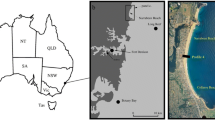Abstract
This work describes a Beach Morphodynamic Model tool (BeachMM) that integrates state of the art wave/morphological numerical models (SWAN and XBeach) within a standard GIS platform (ArcGIS), aiming to streamlining the process related with the beach morphodynamics modelling. The BeachMM tool interface was developed using Python scripting language, taking advantage of its object-oriented and cross platform capabilities as well as its flexibility and strong integration with ArcGIS. In this work, we discuss the merits of this approach through an application example, where the tool was applied to the morphodynamic modelling of an exposed beach located at the Portuguese western coast. This tool has proven its applicability as it greatly simplifies dataflow effort, reduces the human error and provides a dynamic visualization of the modelling results.








Similar content being viewed by others
References
Booij N, Ris RC, Holthuijsen LH (1999) A third-generation wave model for coastal regions. 1. Model description and validation. J Geophys Res 104(7):649–666
Brandmeyer JE, Karimi HA (2000) Coupling methodologies for environmental models. Environ Model Softw 15:479–488
Cheng W, Wang K, Zhang X (2010) Implementation of a COM-based decision-tree model with VBA in ArcGIS. Expert Syst Appl 37:12–17
Crossman ND, Perry LM, Bryan BA, Ostendorf B (2007) CREDOS: a conservation reserve evaluation and design optimization system. Environ Model Softw 22:449–463
DELFT (2005) Delft3D-WAQ: Detailed description of processes. Technical Reference Manual. 397 p.
Deltares (2011) Validation of dune impact models using european field data. Report 1002266, Deltares
Di Luzio M, Srinivasan R, Arnold JG (2004) A GIS-coupled hydrological model system for the watershed assessment of agricultural nonpoint and point sources of pollution. Trans GIS 8(1):113–136
Dias JMA, Jouanneau JM, Gonzalez R, Araújo MF, Drago T, Garcia C, Oliveira A, Rodrigues A, Vitorino J, Weber O (2002) Present day sedimentary processes on the northern Iberian shelf. Prog Oceanogr 52:249–259
ESRI (2010) ArcGIS - A Complete Integrated System. Environmental Systems Research Institute, Inc., Redlands, California. Available via http://esri.com/arcgis. Accessed August 2010
Liao H, Tim US (1997) An interactive modeling environment for nonpoint source sollution control. J Am Water Resour Assoc 33(3):591–603
McCall RT, de Vries JSMVT, Plant NG, Van Dongeren AR, Roelvink JA, Thompson DM, Reniers AJHM (2010) Two-dimensional time dependent hurricane overwash and erosion modeling at Santa Rosa Island. Coast Eng 57:668–683
Oliveira A, Santos A, Rodrigues A, Vitorino J (2007) Sedimentary particle distribution and dynamics on the Nazaré canyon system and adjacent shelf (Portugal). Mar Geol 246(2–4):105–122
Pullar D, Springer D (2000) Towards integration GIS and catchment models. Environ Model Softw 15:451–459
Python Software Foundation (2010) Python Programming Language. Python Soft-ware Foundation, Hampton, NewHampshire. Available via http://python.org. Accessed August 2010
Roberts JJ, Best BD, Dunn DC, Treml EA, Halpin PN (2010) Marine geospatial ecology tools: an integrated framework for ecological geoprocessing with ArcGIS, Python, R, MATLAB, and C++. Environ Model Softw 25:1197–1207
Roelvink JA, Reniers A, Van Dongeren A, De Vries JVT, Lescinski J, Walstra, DJ (2007) Modeling hurricane impacts on beaches, dunes and barrier islands. Proc. 10th workshop on Waves and Coastal Hazards, North Sore, Oahu
Roelvink D, Reniers A, Dongeren V, De Vries JVT, McCall R, Lescinski J (2009) Modeling storm impacts on beaches, dunes and barrier islands. Coast Eng 56(11–12):1133–1152
Roelvink D, Reniers A, Van Dongeren, De Vries JVT, Lescinski J, McCall R (2010) XBeach Model description and Manual. Unesco-IHE Institute for Water Education, Deltares and Delft University of Tecnhology. Report June, 21 2010 version 6
Silva AN, Taborda R, Catalão J, Freire P (2009) DTM extraction using video-monitoring techniques: application to a fetch limited beach. J Coast Res SI56:203–207
SWAN (2009) – Scientific and Technical Documentation (version 40.51). Delft University of Technology, Environmental Fluid Mechanics Section. Available via http://www.fluidmechanics.tudelft.nl/swan/index.html. Accessed August 2010
Van Dongeren A, Bolle A, Vousdoukas MI, Plomaritis T, Eftimova P, Williams J, Armaroli C, Idier D, Van Geer P, De Vries JVT, Haerens P, Taborda R, Benavente J, Trifonova E, Ciavola P, Balouin Y, Roelvink D (2009) MICORE: dune erosion and overwash model validation with data from nine European field sites. Proceedings of coastal dynamics 2009. Paper No 82:1–15
Winterton RL, Livermore RA (2004) A customised GIS to aid Gondwana research. Gondwana Res 7(1):287–292
Zundel AK (2000) Surface-water modeling system reference manual. Brigham Young University, Environmental Modeling Research Laboratory, Provo
Acknowledgments
This paper is a contribution of Red Tango (Red Iberoamericana en Teledetección Aplicada a la Prevención de Riesgos Geológicos Litorales), the European project MICORE – Morphological Impacts and Coastal Risks induced by Extreme storm events (Grant agreement no.: 202798) and the Portuguese foundation for Science and Technology (FCT) project B2C - Beach to Canyon (PTDC/MAR/114674/2009). The first author is financially supported by the FCT through PhD grant (SFRH / BD / 41762 / 2007).
Author information
Authors and Affiliations
Corresponding author
Rights and permissions
About this article
Cite this article
Silva, A.M.A.N., Taborda, R.P.M. Integration of beach hydrodynamic and morphodynamic modelling in a GIS environment. J Coast Conserv 17, 201–210 (2013). https://doi.org/10.1007/s11852-012-0212-5
Received:
Revised:
Accepted:
Published:
Issue Date:
DOI: https://doi.org/10.1007/s11852-012-0212-5




